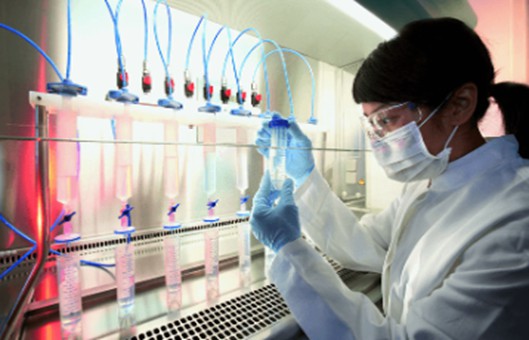GUIDELINE
- The process of fusion of two or more cells of the same or different species into one cell under natural conditions or by artificial means (physical, chemical, or biological) is called cell fusion.
- The chromosome advance agglutination specimen is prepared by fusing M-phase cells with G1-phase cells, and the chromatin of G1-phase cells agglutinates into a single strand of thin and long advance agglutinated chromosomes visible under the light microscope, i.e. G1-PCC. The length and thickness of the chromosomes are closely related to the position of the cells in the G1-phase. Early G1-phase chromosomes are short and thick, while late G1-phase are thin and long. S-phase cells are at the stage of DNA replication, and a large number of replication units do not start replication at the same time, so the chromatin being replicated is highly un-helical and not visible under light microscopy, but only the parts that have not yet replicated or that have replicated and then re-agglomerated. M-phase cells induce chromatin agglutination in S-phase cells in a powdered or crushed granular form, which is visible under electron microscopy. The granular form is the site of high chromatin helicalization, and the granules are connected by the morphology of G2-PCC is close to that of M-phase chromosomes, except that it is less helical, so its staining is light, elongated, and sister chromatids are close to each other.
METHODS
Preparation of M-phase cells
- Pass the cells according to the general method.
- At 2-3 d of culture, when the cells are growing vigorously and in a logarithmic growth phase, add colchicine (final concentration 0.2-0.5 μg/mL) and continue to incubate for 3-4 h in a CO2 constant temperature incubator.
- Gently decant the culture medium, wash the cells twice with 5 mL of Hanks liquid, and discard the dead cells, cell debris, and Hanks liquid.
- Add 5 mL of Hanks solution and shake the culture flask repeatedly for 3-5 min, or gently blow the cell layer repeatedly with a pipette. As the M-phase cells are spherical, the contact area with the flask wall becomes smaller, and they are easily dislodged and suspended in the culture medium. Transfer the cell suspension into a 5 mL graduated centrifuge tube and count the cells.
Prepatarion of interphase cells
- Add 0.25% trypsin solution to the walled cells collected from M-phase cells, digest for 2-3 min, discard the digestion solution, add 5 mL Hanks liquid, repeatedly blow the cell layer with a pipette, transfer the cell suspension into a 5 mL graduated centrifuge tube, and count the cells.
Cell fusion
- Mix the M-phase cells and interphase cells in a 1:1 ratio (about 106 cells each) in a 5 mL centrifuge tube, centrifuge at 800 g for 5 min, and discard the supernatant. The supernatant is discarded. The supernatant is washed and centrifuged twice with 5 mL of Hanks solution, and the supernatant is discarded as much as possible.
- Add 0.5-1 mL of pre-warmed 50% PEG solution at 37°C (39°C is better) in a water bath, slowly add 0.5-1 mL of pre-warmed 50% PEG solution at 37°C drop by drop, and mix gently with a pipette while adding (you can also gently shake and mix during the drop addition process and then gently blow and mix with a pipette). Rest at 37°C for one minute.
- Add 5 mL of RPMI-1640 culture solution without serum (start with 1 mL added slowly drop by drop) and mix well (dilute to terminate the effect of PEG solution). Centrifuge at 800 g for 5 min (can be left at 37°C for 5-10 min before centrifugation) and discard the supernatant.
- Add RPMI-1640 growth medium containing calf serum and mix gently by blowing to keep the cells in suspension.
Production
- Remove the above cells, centrifuge at 800 g for 8 min, and discard the supernatant. Add 10 mL of 0.075 mol/L KCl hypotonic solution to gently make a suspension.
- Treat the cells at 37°C for about 25 min, and add 1 mL of Carnoy fixative for fixation at termination.
- Centrifuge at 1000 rpm for 8 min, discard the supernatant, finger-pop the bottom of the centrifuge tube to disperse the cells, and add 10 mL Carnoy fixative to fix for 30 min.
- Centrifuge at 1000 rpm for 5 min, discard the supernatant, leave 0.2 mL of residual solution, and blow gently with a pipette to form a suspension.
- Take the pre-cooled slide, make a drop sheet, and bake it dry.
- Giemsa stain for about 15min, wash with water, dry, and then microscopically examine.
Creative Bioarray Relevant Recommendations
NOTES
- To ensure the fusion rate, the supernatant should be discarded as much as possible before adding PEG. When adding 50% PEG drop by drop, it should be added slowly and drop by drop, and care should be taken to mix gently during the drop addition.
- After adding PEG and leaving it for 1 min, dilute it 10 times with culture medium, and do it gently. Incubate at 37°C for a longer period (30-60 min) to generally obtain a high percentage of PCC.
RELATED PRODUCTS & SERVICES
